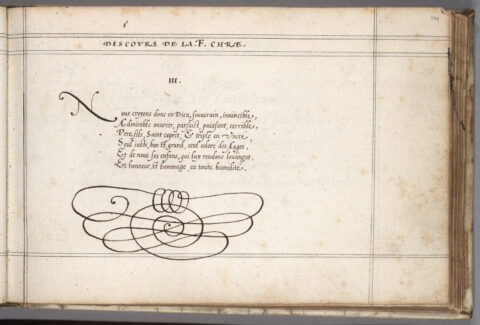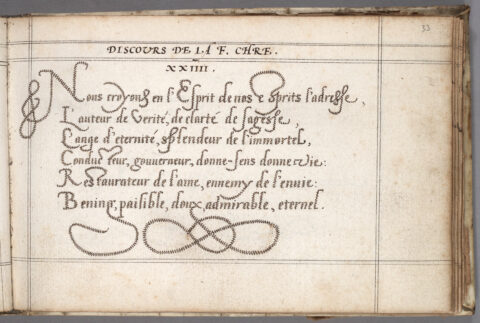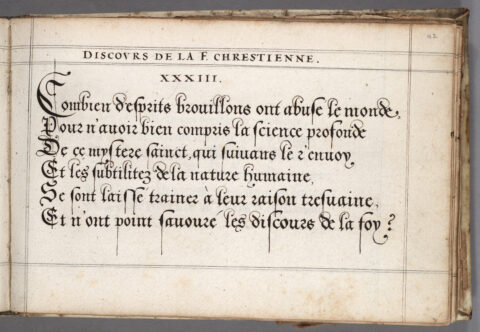In addition to her poems, Esther Inglis also wrote a series of dedicatory letters which she included at the start of her manuscripts. Dedicatory letters are often found in sixteenth- and seventeenth-century printed books, and Esther Inglis continues this tradition in manuscript form.
In her own words
Esther Inglis as author
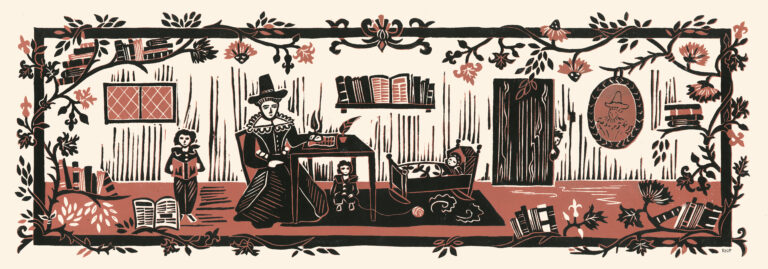
As well as an early-modern scribe, illuminator, and textile artist, Esther Inglis was also a bilingual author who composed her own works of literature in French and Anglo-Scots. Esther Inglis was the author of two long works of poetry, and many shorter verses. She also wrote letters of dedication to the recipients of her manuscripts, asking them to look favourably upon her gifts, and often also demonstrating her wide literary and religious education.
Esther Inglis’ early manuscripts contain verses written to her and her dedicatees by eminent Scottish theologians and writers. By including these verses in her books, Esther Inglis was able to situate herself and her manuscripts within a wider Scottish literary culture. Read on to learn more.
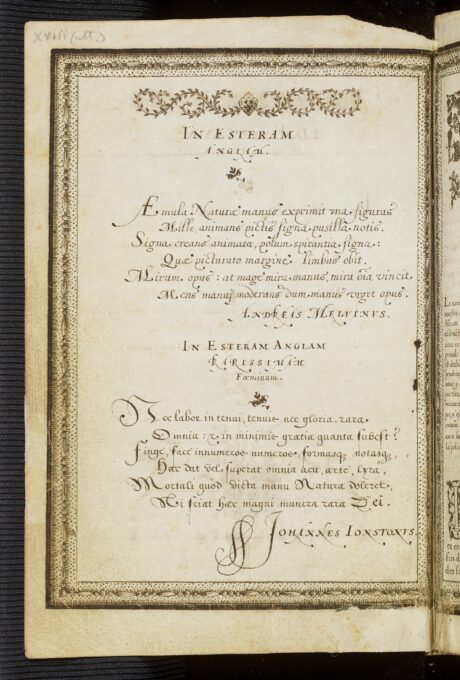
Verses in praise of Esther Inglis
These two Latin epigrams were composed for Esther Inglis by the Scottish writers Andrew Melville (1545-1622) and John Johnstone (c. 1565-1611). Both men were senior figures at the University of St Andrews. In his epigram, Andrew Melville describes Inglis as a rival to Nature, creating “signs that breathe of heaven” [polum spirantia signa] with her pen. Johnstone presents Esther Inglis’ skills as the “rare gifts of the great God” [magni munera rara Dei], saying that her work is better than all that the needle, art, or the lyre can perform.
Click here to see a full digitisation of this manuscript.
|
By including verses written by Andrew Melville, John Johnstone, and Robert Rollock (c.1555-1599) in her early, monochrome manuscripts, Esther Inglis was able to align herself with a particular circle of Scottish presbyterian writers in early-modern Edinburgh. Listen here to Jamie Reid Baxter introducing this circle of writers, and the epigrams written for Esther Inglis and her manuscripts. Click the box to read along with a transcription.
|
A Scots sonnet for Esther Inglis
This sonnet was written for Esther Inglis by a Scots poet who signed his name as “G.D.”, praising her exceptional skills in calligraphy. While some might build monuments or make scientific discoveries, the writer says, Esther Inglis’ skill with the pen is enough to win her “immortal praise and fame”. A “golden pen” was a prize offered in early-modern handwriting competitions which took place in cities across Europe, including Edinburgh and London
This poem is a translation of a French original which was written for Inglis by the Dutch calligrapher, Jan van den Velde (1593-1641). The Scots writer ‘G.D.’ has been identified as George Douglas of Mordington.
Listen to Jamie Reid Baxter in the two audio clips below, first reading the Scots sonnet written for Inglis by G.D., and then Velde’s French original.
|
||||||
| Object reference | Folger Shakespeare Library, V.a.92, folios 4v-5r |
|---|
|
Click the box to read a transcription of this French verse.
|
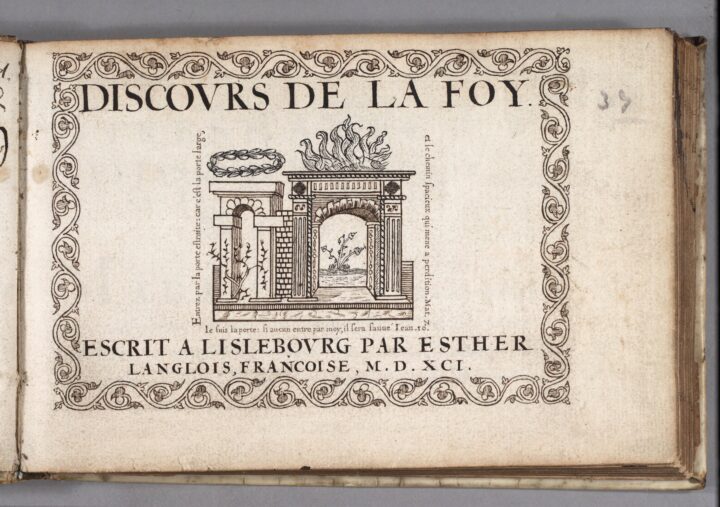
Esther Inglis as a French poet
The longest French work attributed to Esther Inglis is a poetic “discourse” or explanation of the Reformed Christian faith. It is based upon the Apostles’ Creed and Confession, which sets out the underlying principles of Christianity, and shows that Esther Inglis was able to craft powerful verse in her native language. Inglis almost certainly composed the work in 1590, when she was around 20 years old. This manuscript is dated the 1st of January 1591 and was prepared by Esther Inglis as a gift for Elizabeth I of England.
Click here to read a full edition and translation of this manuscript.
Listen to Aline Brodin reading three stanzas from Esther Inglis’ Discours de la Foy and click the images below to read along with Esther Inglis’ original manuscript.
|
|
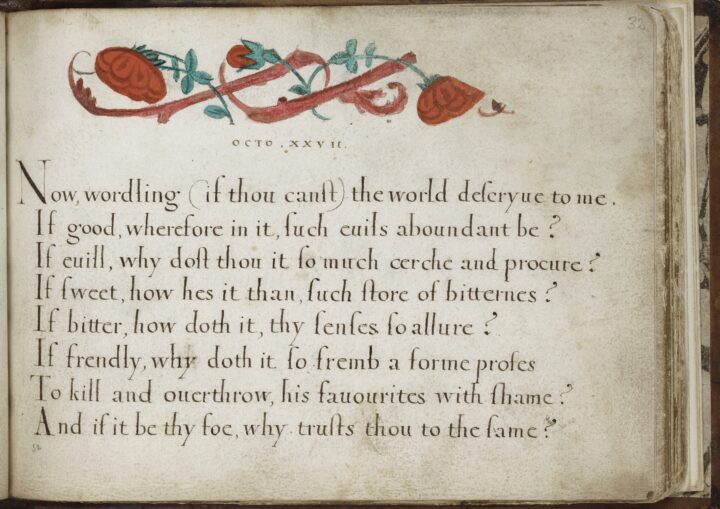
Esther Inglis as a bilingual translator
Alongside the verses which she composed in French, Esther Inglis also translated French poetry into ‘Anglo-Scots’, or English with Scots inflections. Ten of Esther Inglis’ known manuscripts copy the religious Octonaires sur la vanite et inconstance du monde which were composed between 1573 and 1583 by the poet and pastor Antoine de la Roche Chandieu. Esther Inglis also made her own verse translations of these poems, preserved in just three of her surviving manuscripts. This manuscript dates from the time that Inglis and her family spent in London and was presented on the 23rd December 1607 to her landlord in Richmond, William Jeffrey.
|
Until recently, it was widely assumed that Esther Inglis did not have the linguistic skills or education necessary to be the author of her Discours de la Foy or the translator of the Octonaries. This perception of Esther Inglis is now changing; listen here to Jamie Reid Baxter discussing why it is most likely that these poems were composed by Esther Inglis herself. Click the box to read along with the transcription.
|
|
||||||
| Object reference | Folger Shakespeare Library, V.a.91, folios 25v-26r | |||||
|---|---|---|---|---|---|---|
| Credit / Usage information | No Copyright (United States) |
Listen to Dr Jamie Reid Baxter discussing Esther Inglis’ skills as an author of both French and English poetry, and the literary features which her work demonstrates. Click the box to read along with a transcription.
|
Esther Inglis’ literary corpus also includes several shorter verses in French and Scots-inflected English, some of which are contained in the manuscripts she produced between 1599 and 1602. Her other shorter ‘lyric’ verses were written for her children, as shown in the next section of this exhibition.
Follow the arrows to discover one of Esther Inglis’ French verses in greater detail.
|
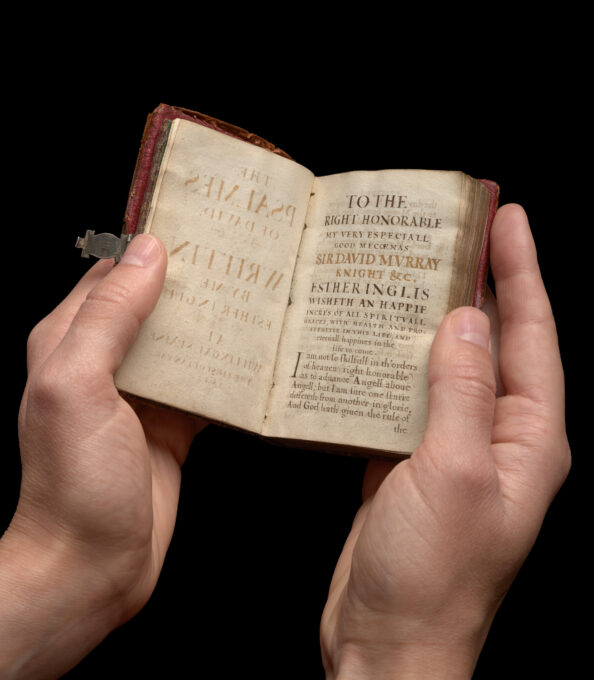
From poetry to prose: Esther Inglis’ dedicatory letters
Around half of Inglis’ known manuscripts contain a dedicatory letter; nineteen are written in French and fourteen in English. Inglis’ letters weave together materials from many different sources including the Bible, classical literature, and early-modern religious texts. They demonstrate the extent of her education while showing her familiarity with the letter-writing conventions of the time.
This is Esther Inglis’ longest prose work: a letter prefacing a beautiful, miniature book of Psalms which she gave to her close friend Sir David Murray in 1612. Click the box to read an extract of this dedicatory letter.
|
Through the manuscripts which survive today, we can know Esther Inglis as a scribe, artist, and author, but this is only to understand one side of her story as a woman living in early-modern Scotland and England. The next section of this exhibition looks at Esther Inglis as a mother, working and raising her children in early-modern Edinburgh, London, and Essex. Read on to learn more.

